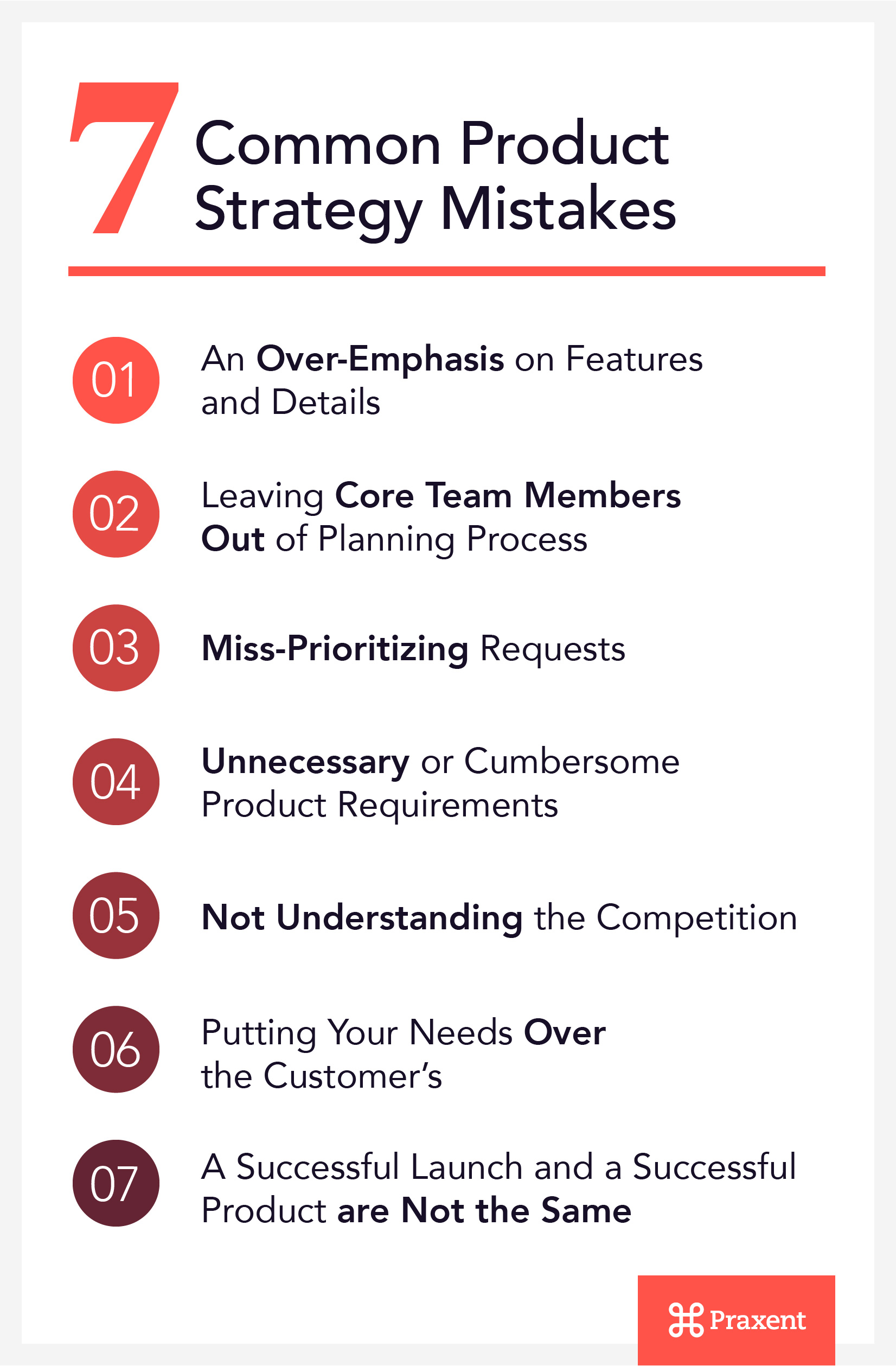
8 min read
7 Horrible Product Strategy Mistakes (and what they may be costing you)
7 Horrible Product Strategy Mistakes (and what they may be costing you)
Don’t let common product strategy mistakes get in the way of your next big project.
Mobile web applications, websites, and other digital products fail for a variety of reasons. You can have the right ideas in place, but if the product somehow misses the mark with users, it’s future will be a dim one. Developing and implementing the right product strategies is critical to ensuring a successful end.
7 Common, But Horrible Product Strategy Mistakes
 1. An Over-Emphasis on Features and Details
1. An Over-Emphasis on Features and Details
As developers, it’s natural to spend time considering product features. We need to make sure that the products we deliver have a high functionality. But don’t let that functionality come at too high of a cost. While you’re looking at building a product that works seamlessly, your user is looking at the benefits, and how it helps them.
The target market for your product must be understood. Your product must be something that offers a clear value to that market. It must solve some sort of problem. If your product is a web application for example, there should be a clear value to the application that is separate from the mobile website – otherwise, it’s simply redundant.
How to Avoid This Product Strategy Mistake
At every step of the product design and development processes, the value of a feature should be clear. Everything you do should add to the value of the product. When you put your decision making through this value-added framework, your end users benefit.
2. Leaving Core Team Members Out of Planning Process
A human-centered product design strategy takes a team effort. One of the easiest product strategy mistakes is not getting everyone involved in the process has a clear and defined role. When you are in the planning stages of the project, it’s critical to gather the right input from everyone involved. When only select members of a team are involved in the planning process, then the needs of certain stakeholders can easily be overlooked.
How to Avoid This Product Strategy Mistake
Luckily, this is one of the easy product strategy mistakes to avoid. It may take restructuring the format of your product strategy planning meetings to include the various people who will touch a project. Your team members bring a unique perspective to any project that they work on.
It’s critical to get the input of all product managers, designers, developers, and engineers. Having an inclusive process at this stage is a helpful way of ensuring that user experience is considered from all angles before your product launch.
3. Prioritizing Requests
The wonderful advantage of agile mobile development is flexibility. When the course needs to be corrected, an agile team is by definition in a better place to take action. That doesn’t necessarily mean that the course should always be corrected.
This may be a client’s first foray into the mobile app world. They may come to the table with good intentions and a desire to build a product that will benefit their users. It’s up to the development team and the project manager to avoid this product strategy mistake, steer the ship in the right direction, and make sure unnecessary obstacles are avoided. Too many requests can keep the project moving in a lateral direction instead of charging forward.
How to Avoid This Product Strategy Mistake
A project manager should know when to correct course and when to push back. Just because the team has the ability to move and complete an unforeseen task, doesn’t necessarily mean they should. The added flexibility within this system is of great benefit, but it needs to be used with the best possible outcome for a project in mind.
4. Unnecessary or Cumbersome Product Requirements
In a similar manner, it’s important to make sure that the project requirements listed are truly necessary. Sometimes either the company or the developer may want to see something within the software product that holds little benefit to the end customer – it would be a mistake to develop these features. It’s also possible that someone wants to see a product requirement that is unnecessarily cumbersome and could negatively impact the UX.
Take for example, if an executive from the client company wants to add product requirements to an application because the website has the same features. Your app should be different from your website. It should simplify the UX in a way that the website doesn’t. Maybe it simplifies online ordering, booking or registrations – where your website is currently more informational. Creating identical products is repetitive and cumbersome.
How to Avoid This Product Strategy Mistake
Every product feature or requirement should serve a purpose. Your mobile website and application should solve problems for your customer and add value. With every decision that needs to be made during the planning process, ask yourself how it might benefit the user.
5. Not Understanding the Competition
Some companies want to build a mobile application simply because the competition has one. Some companies are unaware of what the competition is doing at all. Both extremes can present their own set of problems when it comes to designing and implementing your digital web presence.
How to Avoid This Product Strategy Mistake
This is another of the product strategy mistakes that is easy to avoid. It is critical to have a firm understanding of your company’s place in your niche. This is done by understanding who your key competitors are, and spending time considering your differentiation. Just because your competitor does something, doesn’t mean that you should. Entering the horse race may not be the best way for your company to gain ground.
Ask yourself these questions:
- What makes you different?
- What customer problems do you solve?
- How do your website, mobile application, or other digital properties help you meet your company’s goals?
6. Putting Your Needs Over the Customer’s
Sometimes a company’s needs and their customer needs may not completely align. There is something called the knowledge gap, that impacts the way you relate to your customers. Consider how much-advanced learning you’ve done within your industry. Maybe it took an advanced degree to get where you are. Maybe it’s been hundreds of hours of industry books, workshops, and self-learning. This puts you at a tremendous advantage, but you have to exercise careful deliberation on how to educate your clients.
Your customer doesn’t have that advanced skill set. They have a need that sent them to your website or app. They are in search of the best means for meeting that need. If you talk over their heads, it won’t resonate. If you plan to develop product features that don’t offer customer value, there’s a disconnect.
How to Avoid This Product Strategy Mistake
Talk with your customers about product requirements. Consider the questions they are frequently asking. What problems are your customers routinely faced with that your product can solve? If you can develop online products aimed at alleviating your users’ needs, your website or mobile app will be more likely to succeed.
7. A Successful Launch and a Successful Product are Not the Same
It’s important to put your best foot forward for a product launch. Make sure that the marketing and PR strategies are in place. But overemphasizing the product launch strategies at the expense of the quality of the product can set you up for trouble down the road. A premium launch of an average or below average product won’t go nearly as far.
How to Avoid This Product Strategy Mistake
It’s essential to take all the steps necessary for a detailed product launch. Make sure that you consider all your marketing and PR channels and have an effective message to get out to your audience through email, social media, press releases, or any other means.
But this shouldn’t be done at the expense of the product. A viable product that provides value to your customers in an effective manner should be priority number one. When you do this step right, word of mouth can be a powerful ally that will also help you to win the day and avoid one of the worst product strategy mistakes.


Leave a Reply